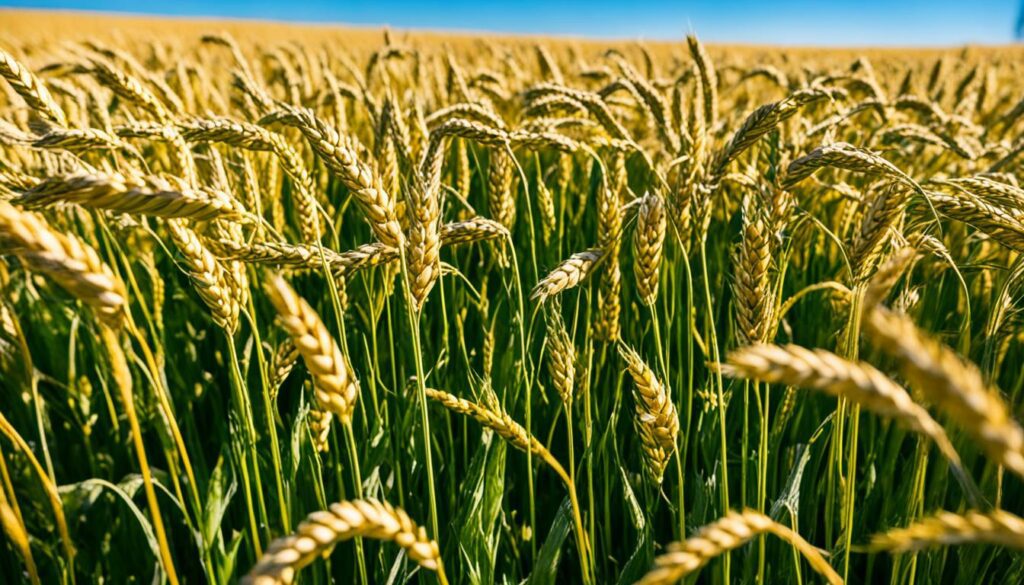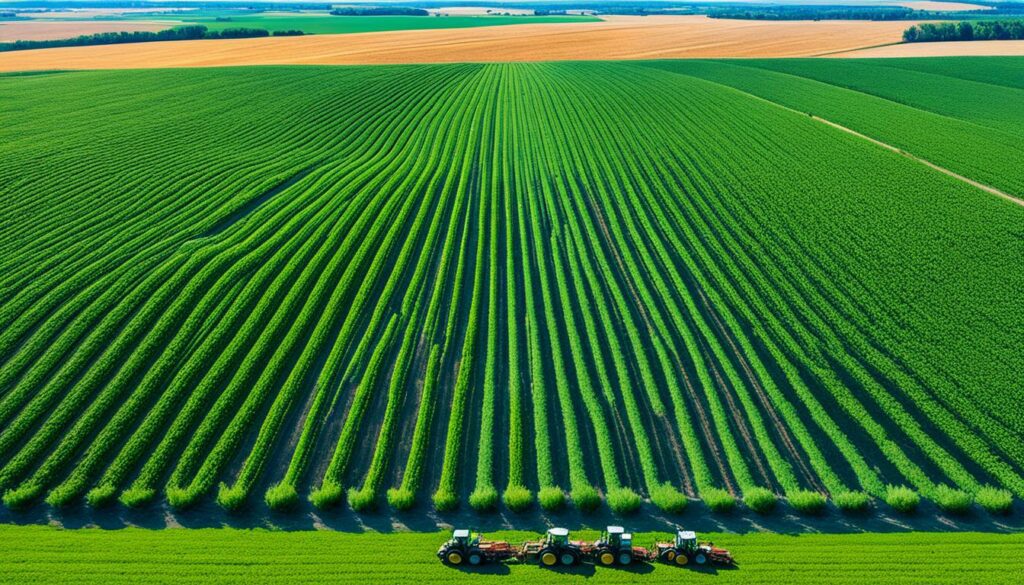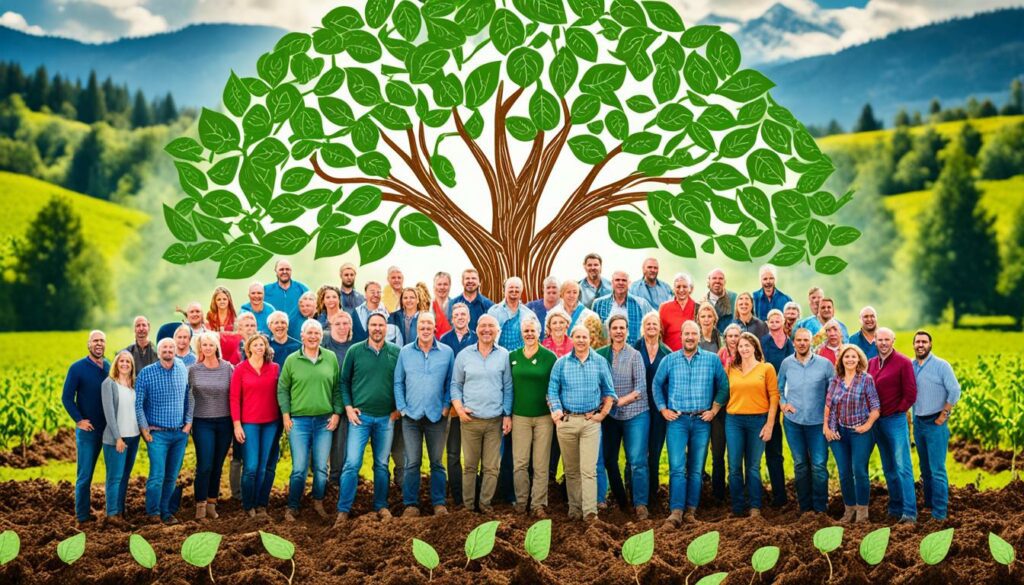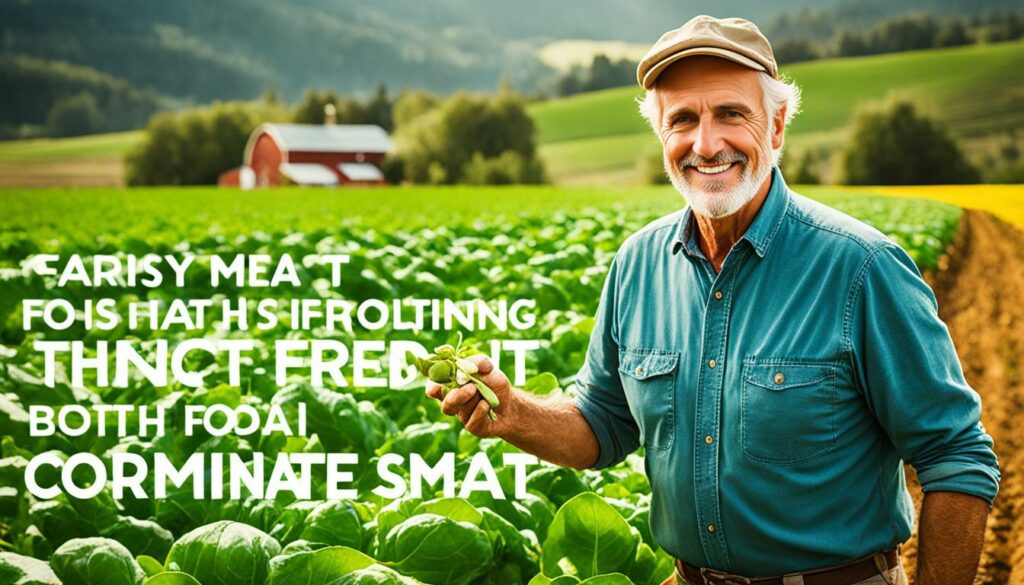Menu

Did you know, the global agrifood system creates a third of all emissions? We aim to feed 9.7 billion people by 2050. Yet, the way we farm needs to change to protect the planet. Currently, agriculture uses 70% of the planet’s freshwater. But it gets little support. Only 4% of climate funds go to farming, with small farmers receiving even less.
Getting money for climate-smart farming is vital. This kind of farming boosts production, makes farms tougher against climate change, and cuts emissions a lot. It’s not just about money; it’s about the future of our food and our planet.
Climate-Smart Agriculture (CSA) is an innovative way to increase farm output while fighting climate change. It focuses on making farms more resilient and eco-friendly. By using CSA, we tackle the challenges of climate change in farming. This helps ensure we have enough food and protects the planet.
CSA combines three goals: make farms more productive, able to withstand change, and reduce harm to the environment. The World Bank now spends nearly $3 billion a year on these measures. It shows how important it is to use these methods for fighting climate change. Now, all new projects must meet the goals of the Paris Agreement, showing a big push for eco-friendly farming.
Countries like Bangladesh, Kenya, and Zimbabwe have special plans for CSA. These plans help their farmers adjust to a changing climate. It’s part of a global effort to make farming safer and more sustainable.
CSA’s triple win aims to benefit farm output, resilience, and the environment:
By using CSA, we help farms thrive, even in a changing climate. This also helps protect our planet.
| Objective | Impact |
|---|---|
| Productivity | Increase food production to meet the needs of 9.7 billion people by 2050. |
| Resilience | Strengthen agricultural systems against climate disruptions. |
| Emissions Reduction | Lower agriculture-related greenhouse gas emissions. |
Our world’s agrifood system is a big emitter of greenhouse gases. It accounts for one-third of all the emissions. We urgently need more agriculture financing for Climate-Smart Agriculture (CSA) projects. By 2050, the need for food is expected to rise greatly with almost 10 billion people worldwide.

Currently, only 4% of climate funds are given to global agrifood systems. And just a fifth of that goes to small farmers. This low support is a problem. Our food supply needs to grow sustainably to meet future demand and tackle climate change.
More investment in CSA can help fix these issues. The World Bank is one body stepping up. It now puts nearly $3 billion each year into Climate-Smart Agriculture. These efforts follow the goals of the Paris Agreement to make agriculture more climate-resilient.
Here are some big projects that show how important agriculture financing is:
These projects prove that major agriculture financing for CSA is crucial. It is key to overcoming the big challenges our global agrifood systems face.
Getting enough money for Climate-Smart Agriculture (CSA) projects means looking into different places. Each source has its own good points and can really help projects move ahead. The main places where funding comes from are government money, help from international groups, and private investors.
Support from governments is key to making CSA successful. Agriculture worldwide makes a big chunk of greenhouse gases. This is why it’s important for governments to help make big changes. The World Bank, for example, now puts nearly $3 billion each year into funding Climate-Smart Agriculture. This includes green farming grants and other help to reduce harmful emissions.
Getting money for CSA from groups and partners around the world is important. The World Bank is a big player in giving loans for green projects. It has supported China with US$345 million for eco-friendly farming. In Eastern and Southern Africa, it’s put up US$621 million to help food systems get stronger. These investments are steps towards reducing methane and making land use more sustainable worldwide.
Private companies are vital in fighting the climate crisis. They put in a lot of global money towards better practices. The Midwest Climate-Smart Commodity Program is a good example. It works with thousands of producers to make farming smarter for the climate. Private investment makes up a large part, around 62%, of the USD 391 billion used for climate actions.
The USDA works hard to bring climate-smart farming to the U.S. They have started many programmes to help farmers use better methods. These include proposal strategies aimed at climate-smart agriculture.

The USDA sets up webinars to help farmers with proposals. Here, farmers can meet others and learn from them. The focus is on helping small and minority farmers too.
The USDA teams up with others to make its work go further. For example, the project Farmers for Soil Health Climate-Smart Commodities Partnership has $95 million to help farmers in 20 states grow cover crops. The Trueterra project is also doing good, working with 11 groups that help underprivileged farmers. They’ve helped with many acres, promoting the use of USDA’s methods.
The World Bank plays a key role in funding climate-smart agriculture (CSA) projects. This is vital because the agrifood system causes a third of the world’s emissions. A big focus on CSA helps us reach sustainable development goals. Also, it tackles challenges like high methane from food systems and loss of wildlife.
The World Bank now puts almost $3 billion yearly into CSA, eight times more than before. This shows how serious the bank is about helping our planet. And, after July 2023, all the bank’s new work must follow the Paris Agreement. This helps aim all actions at world climate goals.
Some of the World Bank’s key projects include the Food Systems Resilience Program in Eastern and Southern Africa. It helps countries like Kenya and Malawi make their food systems stronger with $621 million. Also, in Pakistan, the PRIAT project worth $200 million works to make farming more resilient and open to more people.
The ARDI programme in Jordan, funded with $125 million, aids in making agriculture more climate-smart and competitive. Another $40 million supports research to improve CSA in parts of Africa. This includes using new technologies to fight climate change.
Other groups are also pitching in. The Bill & Melinda Gates Foundation plans to give $18.8 million to support CSA research. Plus, the Office Chérifien des Phosphates will invest $5 million in a soil project in West Africa. These partnerships underline the World Bank’s crucial part in funding CSA and helping to achieve sustainable goals worldwide.
To get climate-smart agriculture funding, you must plan well and know the funding process. Following clear steps is crucial to make your proposal shine.
At the start, describe your aims in detail. Define what you want to achieve with your project. Make sure these aims can be measured and fit the funding body’s goals. Also, show how your project’s goals match the funding priorities, state your objectives clearly, and explain the expected impact.

For example, the USDA’s Climate-Smart Commodities Partnerships have two types of funds. One pool is for projects between $5 million and $100 million. Submissions are due on May 6, 2022. The other is for projects from $250,000 to $4,999,999, with a deadline on June 10, 2022.
To boost your chances, cover some key points in your application. Describe the methods and tech your project will use. Explain how they’ll make farming better, stronger, and cleaner.
Also, show that your project will help everyone, especially small or less supported farmers. Use feedback from nearly 400 comments in the USDA’s Request for Information. This feedback underlines the need for fairness and positive change.
The USDA allocates money through the Commodity Credit Corporation for new ideas. It supports projects encouraging smart farming and new markets for these products. Many types of groups can apply, from county bodies to schools. Using these funds right can help you get the support you need.
Getting funding for Climate-Smart Agriculture (CSA) is key for better farming and protecting the Earth. Using the right methods when applying for CSA funding can really help your chances.
Firstly, making strong partnerships is vital. Working with government, outside groups, and businesses can bring big support. For example, the World Bank helps CSA a lot, putting in $3 billion each year.
Writing a good, clear proposal is also very important. Your plan should show what you want to achieve, how you will do it, and why your project is needed. Don’t forget to explain how others can get involved and how your project will fit in the local community.
Knowing about available funding is a must. The climate fund gives very little to farming, even though it causes a lot of the problems. Look at successful projects like Kenya’s US$621 million and Pakistan’s US$200 million. They can teach you how to use and get funds well.
It’s key to show your project will help the planet and make money. Farming and food use create a lot of pollution and harm the environment. So, choose projects that fight this, like smart irrigation and tree planting. These not only protect nature but also help farmers earn more.
| Key Zones | Funding Focus | Recent Projects |
|---|---|---|
| Eastern and Southern Africa | Resilience of Food Systems | US$621M FSRP Project |
| Pakistan | Inclusive Agriculture Transformation | US$200M PRIAT |
| Jordan | Agriculture Resilience & Innovation | US$125M ARDI Program |
Lastly, stay open to new ideas to match different farm situations. It’s important to find and use new methods to fit the local area. Ideas like using less chemicals and managing soil better help the environment and make farms more profitable.
The effects of climate change on farming are serious. It needs solid financial help. Access to international funds is key. This is where multilateral agencies come in. They help us carry out bigger climate-smart agriculture projects.
The World Bank and the UN are big helpers for CSA. They provide special ways to fund greener farming, focusing on fighting climate change. Take the Farmers for Soil Health Climate-Smart Commodities Partnership. It wants to help 1 million acres with cover crops in 20 states. They have $95,000,000 to push this forward. The Midwest Climate-Smart Commodity Program also gives 20% of its deals to those in need, with up to $95,000,000.
Getting global grants helps grow CSA. These grants support eco-friendly farming and welcome everyone to join in. The Strengthening Grassroots Leadership and Capacity aims to include many from poorer areas. It has $90,000,000 to help, working through 3,000 conservation groups. Another big project is Climate SMART. It wants to be in 43 states and help 11 struggling farming groups to be green, also with $90,000,000.
| Programme | Funding Ceiling | Key Focus |
|---|---|---|
| Farmers for Soil Health Climate-Smart Commodities Partnership | $95,000,000 | 1 million acres of cover crops |
| Midwest Climate-Smart Commodity Program | $95,000,000 | 20% contracts for underserved populations |
| Strengthening Grassroots Leadership and Capacity | $90,000,000 | Half of participants from underserved communities |
| Climate SMART (Scaling Mechanisms for Agriculture’s Regenerative Transformation) | $90,000,000 | Equip 11 underserved producer organisations |

Getting these international funds from multi-agencies is vital. They let us link green goals and real farm needs, making farming stronger in shifting climates.
Climate change is greatly affecting agriculture. It changes how much and the quality of crops we grow. With more people to feed – around 9.7 billion by 2050 – the pressure is on. Farming and the food system cause one-third of all global emissions. This shows we must make our farms resilient to climate change.
Surprisingly, only 4% of money for fighting climate change goes to farms. And just a fifth of that helps small farmers. This lack of support means we must invest more in smart farming. The World Bank is stepping up, increasing its help to farmers to almost $3 billion yearly. Now, it requires all its projects to follow the Paris Agreement, linking farming and climate protection together.
An example is the ARDI programme, which plans to help 30,000 farming families over five years. It teaches better ways to farm and gives new tech. In the US, the Biden-Harris team put aside an extra $325 million for 71 climate farming projects. All these efforts show a big commitment to making farming more weather-proof.
These projects are expected to make a big difference. They could reach over 60,000 farms and more than 25 million acres of land. The goal is to remove as much CO2 as over 12 million cars would in a year. This is a huge step in fighting climate change by making farms smarter.
| Statistic | Data |
|---|---|
| Global agrifood system emissions | One-third of all emissions |
| Projected global population by 2050 | 9.7 billion |
| Proportion of climate finance to agrifood systems | 4% |
| Annual World Bank financing for CSA | Almost $3 billion |
| Additional USDA investment under Biden-Harris Administration | $325 million for 71 projects |
| Total investment in Partnerships for Climate-Smart Commodities | $3.1 billion |
| Number of farms engaged in climate-smart practices | More than 60,000 |
| Carbon sequestration over project lifespan | 60 million metric tons CO2-equivalent |
Many universities are key players in these efforts. Almost 100 are taking part, with more than 30 aimed at helping minorities. Black and Hispanic-serving schools are leading the way too. They offer a wide range of skills for making our farms ready for the future.
Climate-Smart Agriculture (CSA) improves how we grow food. It helps farmers face climate challenges while aiding the planet.
CSA boosts both crop yield and quality. It uses smart methods fit for each area, making crops tougher against weather changes, diseases, and pests. This boosts how much food is grown and its quality, helping keep the world fed.

With a growing population, we must produce more food by 2050. CSA’s resilience is key. It helps stabilize food supplies, even with climate’s ups and downs.
Furthermore, CSA helps the environment. Traditional farming is a big source of greenhouse gases. CSA cuts these gases down with green farming practices.
Take China’s Green Agricultural Programme. It lessens emissions from farming, boosting carbon trapping. Such work is vital for reducing farming’s footprint and saving plants and animals. Using water wisely in these methods also helps a lot.
| CSA Initiative | Objective |
|---|---|
| China Green Agricultural and Rural Revitalization Program | Reduce GHG emissions and increase carbon sequestration |
| Food Systems Resilience Program for Eastern and Southern Africa | Increase resilience and preparedness for food insecurity |
| Punjab Resilient and Inclusive Agriculture Transformation Project | Enhance access to agricultural water and improve farmer incomes |
| Agriculture Resilience, Value Chain Development and Innovation program in Jordan | Support climate-smart and water-efficient practices for 30,000 farming households |
Projects around the globe have highlighted how climate-smart agriculture (CSA) boosts sustainable farming. This approach doesn’t just improve how much food we grow. It also helps farms withstand the changing climate. As a result, both people and the planet win.
Take the Kihamba agroforestry system in Tanzania for example. This system covers 120,000 hectares and supports a million people. By better managing coffee, farmers here increased their income by 25 percent in three years. This shows how CSA can make a big, positive change for everyone.
China’s Three Rivers Sustainable Grazing Project is shining as a model for sustainable farming. It estimates it can reduce 63,000 tonnes of CO2 in its first decade. This reduction comes by fixing degraded lands and storing more carbon in the soil. The project aims to not only help the land but also boost profits and protect herder communities.
| Project | Objective | Impact |
|---|---|---|
| Farmers for Soil Health Climate-Smart Commodities Partnership | Enhance soil health and reduce emissions | Agreement amount: $95,000,000 |
| Midwest Climate-Smart Commodity Program | Foster resilient agricultural practices | Funding ceiling: $95,000,000 |
| Strengthening Grassroots Leadership Project | Empower rural agricultural communities | Funding ceiling: $90,000,000 |
The ADM and Partners’ Climate-Smart Solutions Project has also made a big impact. By working with 5,000 farmers in 15 states, it supports changes that save money. These projects show how important and effective CSA can be for farming communities.
The world will need a lot more food by 2050 to feed nearly 10 billion people. This makes sustainable farming examples critical. Projects like these not only feed people but also protect the environment. Investing in sustainable farming is the key to a strong agricultural future.
Many organisations and governments find getting climate-smart agriculture (CSA) funding hard. A lack of funds can stop the use of important sustainable farming methods. I will talk about why getting CSA funding is tough and how we can solve these problems.

Trying to get CSA funding faces several obstacles like complex rules and not enough money. I will discuss the top three hurdles and ways to beat them:
One big issue is that many don’t know enough about eco-friendly farming. Solving this needs a big effort in teaching and talking to people. Working with the community and local leaders spreads the word about what works best.
Getting funds is hard when each funding source has its own tough rules. To beat this, do deep research on the funders. Make your pitch fit their goals. This can really improve your chances.
There’s a lot of competition for funding, especially for big eco-farming projects. Working with different groups can help. By teaming up with others, you can get to more funding sources.
Efforts like the Great Green Wall for the Sahara and the Sahel Initiative (GGWSSI) show how teaming up works. They fight desert damage with big tree-planting projects. Also, getting more public and private money for eco-farming boosts these projects. This makes eco-farming a choice for more investors.
To get over these funding challenges, you need to work in many ways. Teaching more about eco-farming, matching funding rules, and working with others are key. With everyone’s hard work, we can make the path smoother for eco-farming.
Farmers worldwide are facing big challenges from climate change. To help them, new and innovative ways of financing climate-smart farming are popping up. These cover a wide range of support to make farming more innovative and sustainable.
Exciting new chances in how we fund climate-smart farming stand out. The World Bank, for example, is investing $3 billion each year in these efforts. This shift shows a big move towards farming that’s eco-friendly and supports our planet, in line with the Paris Agreement.
There have also been big investments recently. China got a US$345 million loan for its eco-friendly farming plans. African nations received a US$621 million boost to make their food systems stronger and emit less harmful gases. These moves help our food systems get ready for a future with more people to feed.
Another clever idea is to fund farming that helps the environment by selling the good services it does. This model includes support from various types of investors, who earn money by helping farmers through a change to better practices. This funding method also includes help from many experts and supporters, making sure farmers get the help they need.
The way we fund climate-smart farming is quickly changing and getting better. As we all work together in these new opportunities, the way we farm in the future will be both strong and different. We are moving towards farming that not only produces food but also takes good care of our planet.
Government programmes are key in boosting Climate-Smart Agriculture (CSA) nationwide. They match national aims with agricultural sustainability. This helps spread the use of smart farming practices. These steps assist farms in staying strong against climate changes.
The Climate Smart Agriculture and Rural Enterprise Programme (SAEP) runs from 2018 to 2024. This plan helps folks by offering skills, investing in agriculture, and teaching about smart climate practices. It provides scholarships for job skills to help the youth.
Farmers and fishers can get special grants for projects that help the economy and the environment. Beyond this, the SAEP aids business owners with special services. It boosts business in rural areas and focuses a lot on young people starting out.
Also, the SAEP helps fix farm roads and drainage, and improves water systems. It supports making agriculture more climate-resilient. Kids learn about CSA through school groups like the 4H Club.
The SAEP is an example of how government help is vital for CSA. It joins up with others to handle money, give advice, and check on things. This approach has led to big projects, involving companies like PepsiCo and Cargill. These partnerships have spread CSA to millions of acres and helped various farm areas in the country.
Climate-smart agriculture funding is money that helps with farming in ways that are good for the environment. It focuses on doing better in farming while using less energy. This way helps keep our planet healthy.
Funding for climate-smart farming is key to making our farms better for the future. It stops bad effects of climate change on our food. Also, it keeps our environment safe and helps farmers do well.
The ‘triple win’ approach makes sure farming not only makes more food and stronger against problems. It also cuts down on things that harm the earth. This way, farming helps the land and keeps the air clean.
The global agrifood system causes a lot of the world’s pollution. This pollution changes our climate, making farming harder. The world will need more food by 2050, which makes farming’s job even tougher.
Money for smart farming comes from many places. Governments, global groups, and businesses all pitch in. This mix helps the right projects get the money they need to grow.
The USDA helps by bringing people together online to talk about better farming. These meetings help with learning and reaching out to smaller farmers. They also share the best ways to sell smartly farmed goods.
The World Bank works hard to support smarter farming around the world. It aims to meet the Paris goals and help countries farm better against climate change. Its big investments help make farms ready for any weather.
To get the funding, your plan must be clear and match what donors care about. Show how your project can really make a difference. This will make people more likely to give you the money you need.
To secure funding, it’s crucial to build strong partnerships and make a good, clear plan. You need to know where to look for money and show how your project helps both nature and the economy. This helps a lot in getting the support you need.
You can get money from international sources for your smart farming projects. Look to multilateral agencies for grants and other financial help. This is key for making big changes in farming around the world.
Climate change is a big threat to farming. It can harm the amount and quality of food we grow. By using smart farming techniques, we can fight back and make our farms stronger against these challenges.
Smart farming helps us grow better food in a way that’s safe for the environment. It boosts the amount and quality of crops, making food more secure. Plus, it reduces pollution and encourages more plant and animal life. This makes farming last longer and do more for the planet.
Yes, smart farming has been very successful around the world. These projects show how good farming can help both people and the earth. They have made farming stronger and our food supply more secure.
Getting funding for smart farming can be a challenge due to needing more knowledge, understanding tough rules, and facing lots of competitions. You can beat these challenges by doing your research well, tailoring your proposals, and working together for a stronger application.
New trends and opportunities will shape the future of smart farming finance. Staying up-to-date with these changes is important for everyone involved in smart farming. It will help keep the progress going and open new ways to get the money needed.
Many governments have programmes that help with smart farming. They fund research and offer financial help to farmers who farm wisely. These programmes are key to making sure smart farming spreads and its benefits are felt by many.